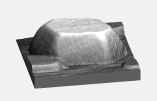Organic Nanostructures
On the Smallest Crystals and Mickey Mouse Patterns on Surfaces
Over the past few years the interest in organic molecules within the context of surface science has drastically increased. In the past, molecules like copper-phthalocyanine (CuPc) and 3,4,9,10 perylenetetracarboxylic-dianhydride (PTCDA) have been seen only as "passive" dye pigments, but in today's optoelectronic devices (solar cells and displays) they play an active role. The interaction of the molecules with their local environment is important for the properties of bulk and of thin films. As a consequence, the conductivity within an organic layer is not isotropic.
In our group we have launched two projects that study the interaction of the molecules with their local environment.
The growth of homogeneous layers. Besides the molecule-molecule interaction which is important for the bulk crystal there is a molecule substrate interaction at least for the first few layers on the substrate. In this context the scanning tunneling microscope (STM) is a useful tool to study the growth from the first nucleation center to nanocrystalites with a height of about 100 layers.
The growth of heterogeneous layers. For this experiment we prepare two molecular species - by sequential evaporation - on the substrate surface. The aim of this project is to study the interaction of both species. As one molecule may act as an electron donor and the other as an electron acceptor we hope to observe the local result of a charge transfer between the two types of molecules.


